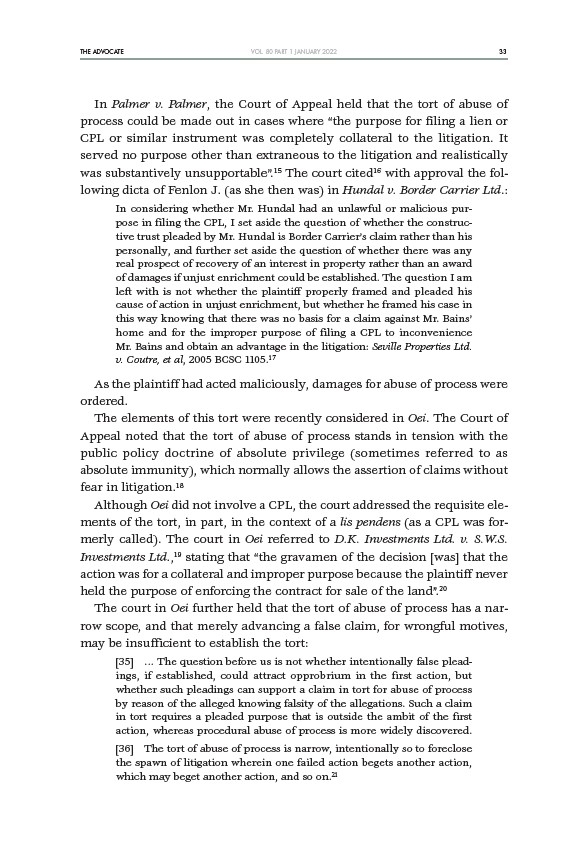
THE ADVOCATE 33
VOL. 80 PART 1 JANUARY 2022
In Palmer v. Palmer, the Court of Appeal held that the tort of abuse of
process could be made out in cases where “the purpose for filing a lien or
CPL or similar instrument was completely collateral to the litigation. It
served no purpose other than extraneous to the litigation and realistically
was substantively unsupportable”.15 The court cited16 with approval the following
dicta of Fenlon J. (as she then was) in Hundal v. Border Carrier Ltd.:
In considering whether Mr. Hundal had an unlawful or malicious purpose
in filing the CPL, I set aside the question of whether the constructive
trust pleaded by Mr. Hundal is Border Carrier’s claim rather than his
personally, and further set aside the question of whether there was any
real prospect of recovery of an interest in property rather than an award
of damages if unjust enrichment could be established. The question I am
left with is not whether the plaintiff properly framed and pleaded his
cause of action in unjust enrichment, but whether he framed his case in
this way knowing that there was no basis for a claim against Mr. Bains’
home and for the improper purpose of filing a CPL to inconvenience
Mr. Bains and obtain an advantage in the litigation: Seville Properties Ltd.
v. Coutre, et al, 2005 BCSC 1105.17
As the plaintiff had acted maliciously, damages for abuse of process were
ordered.
The elements of this tort were recently considered in Oei. The Court of
Appeal noted that the tort of abuse of process stands in tension with the
public policy doctrine of absolute privilege (sometimes referred to as
absolute immunity), which normally allows the assertion of claims without
fear in litigation.18
Although Oei did not involve a CPL, the court addressed the requisite elements
of the tort, in part, in the context of a lis pendens (as a CPL was formerly
called). The court in Oei referred to D.K. Investments Ltd. v. S.W.S.
Investments Ltd.,19 stating that “the gravamen of the decision was that the
action was for a collateral and improper purpose because the plaintiff never
held the purpose of enforcing the contract for sale of the land”.20
The court in Oei further held that the tort of abuse of process has a narrow
scope, and that merely advancing a false claim, for wrongful motives,
may be insufficient to establish the tort:
35 … The question before us is not whether intentionally false pleadings,
if established, could attract opprobrium in the first action, but
whether such pleadings can support a claim in tort for abuse of process
by reason of the alleged knowing falsity of the allegations. Such a claim
in tort requires a pleaded purpose that is outside the ambit of the first
action, whereas procedural abuse of process is more widely discovered.
36 The tort of abuse of process is narrow, intentionally so to foreclose
the spawn of litigation wherein one failed action begets another action,
which may beget another action, and so on.21